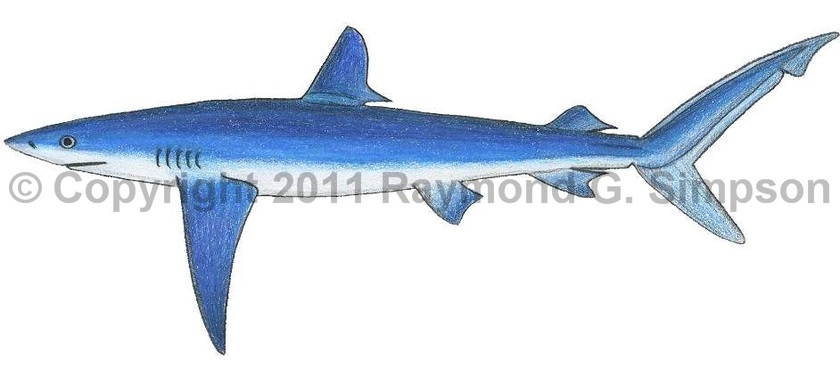
Common Name
Blue Shark
Year Described
Linnaeus, 1758
Identification
Anteroposterior tooth rows: 12-15/12-13 on each side; 27-30/27-30 total
Vertebrae: 142-151 precaudal, 237-252 total
A large shark with a very slender body. Snout very long with a pointed tip. Eye small. Distance between nostrils 2.3-2.6 times in pre-oral distance. Nasal flaps rudimentary and very short. Upper labial furrows very short. Interdorsal ridge is absent. Long preanal ridge absent. A weak keel present on caudal peduncle. Gill slits long (2.9-3.4% TL). Inner gill arches with papillae (unique in family). Teeth in upper jaw broad and triangular, with a distinctly curved serrated cusp. Lower jaw teeth narrowly triangular with serrations at the tip. First dorsal fin low (5.6-7.6% TL) with a convex anterior margin, a rounded tip, and inserted well behind pectoral rear margin. First dorsal inserted closer to pelvic fin than pectoral fin (unlike Carcharhinus spp. where it is closer to pectoral fin). Second dorsal fin smaller (2.1-3.1% TL) and inserted slightly posterior to anal fin. Both dorsal fins with extended free posterior tips (second dorsal free tip 1-1.5 times higher than height of second dorsal). Anal fin similar in size to second dorsal fin. Pelvic fin closer to anal fin than to dorsal fin. Pectoral fin very long and narrow, with a rounded tip.
Color
Body dark blue above, grading to bright blue on the sides, and white on the belly. Pectoral and anal fins sometimes with dusky tips.
Size
Mature adults common from 166-335cm TL. Newborns from 34-48cm. Maximum size to 380cm TL.
Habitat
An offshore species found in open waters near the surface. Only rarely in coastal waters.
Range
Almost the entire open western Atlantic from Canada to Argentina. Apparently very rare or absent in the Gulf of Mexico and Caribbean.
References
Castro, J.I. 2011. The Sharks of North America. Oxford University Press, 640 pp.
Compagno, L.J.V. 2002. Sharks. In: Carpenter, K.E. (Editor) FAO Identification Guide for Fishery Purposes. The Living Marine Resources of The Western Central Atlantic. Volume 1: Introduction, mollusks, crustaceans, hagfishes, sharks, batoid fishes, and chimaeras. ASIH Special Publication No. 5. FAO, Rome.
Compagno, L., M. Dando, and S. Fowler. 2005. Sharks of the World. Princeton University Press, 480 pp.